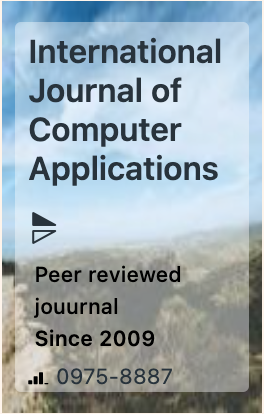The week's pick
Random Articles
Reseach Article
Building an AI-Native Software Engineering Team: A Stepwise Approach using Multi-Agent Systems
| International Journal of Computer Applications |
| Foundation of Computer Science (FCS), NY, USA |
| Volume 186 - Number 21 |
| Year of Publication: 2024 |
| Authors: Hariharan Balasubramani |
 10.5120/ijca2024923651
10.5120/ijca2024923651
|
Hariharan Balasubramani . Building an AI-Native Software Engineering Team: A Stepwise Approach using Multi-Agent Systems. International Journal of Computer Applications. 186, 21 ( May 2024), 41-45. DOI=10.5120/ijca2024923651
Abstract
The realm of Generative Artificial Intelligence (Gen AI) has propelled human ingenuity to unprecedented heights, promising to revolutionize the field of software engineering. Large Language Models (LLMs) and Generative Pre-trained Transformers are at the forefront of this transformation, reshaping the landscape of Software Engineering. With the integration of multi-agent systems, the evolution of software engineering is poised to accelerate even further. Multiple generative agents interacting with each other can handle not only basic tasks like coding, debugging, and scripting, but also creativity-intensive tasks and other aspects of the software engineering lifecycle such as requirement gathering, software design, project planning, QA testing, and documentation. Human engineers will play a crucial role in providing high-level instructions and making course corrections. The emergence of AI-native firms with AI-driven software engineering teams will lead to significantly reduced turnaround times for ideas to become finished products. This approach will streamline the entire software development process, from requirement gathering and planning to the final product, resulting in faster delivery and lower production and operational costs compared to traditional IT firms. In this paper I will provide empirical evidence for the above claims and a stepwise framework for building such a team.
References
- Towards Data Science, 2020. *Designing AI-Driven Software Engineering Teams*. [online] [Accessed 21 May 2024].
- Saklamaeva, V. and Pavlič, L., 2023. The Potential of AIDriven Assistants in Scaled Agile Software Development. Applied Sciences, 14(1), p.319.
- Hou, X., Zhao, Y., Liu, Y., Yang, Z., Wang, K., Li, L., Luo, X., Lo, D., Grundy, J. and Wang, H., 2023. Large Language Models for Software Engineering: A Systematic Literature Review. *arXiv preprint*, arXiv:2308.10620 [cs.SE].
- J. Biolchini, P. G. Mian, A. C. C. Natali, and G. H. Travassos, “Systematic review in software engineering,” System engineering and computer science department COPPE/UFRJ, Technical Report ES, vol. 679, no. 05, p. 45, 2005.
- A Survey on Large Language Models for Software Engineering Quanjun Zhang, Chunrong Fang, Yang Xie, Yaxin Zhang, Yun Yang, Weisong Sun, Shengcheng Yu, Zhenyu Chen arXiv:2312.15223 [cs.SE]
- Autonomous Agents in Software Development: A Vision Paper Zeeshan Rasheed, Muhammad Waseem, Kai-Kristian Kemell, Wang Xiaofeng, Anh Nguyen Duc, Kari Systä, Pekka Abrahamsson arXiv:2311.18440 [cs.SE]
- J. Devlin, M.-W. Chang, K. Lee, and K. Toutanova, “Bert: Pretraining of deep bidirectional transformers for language understanding,” arXiv preprint arXiv:1810.04805, 2018.
- OpenAI. 2023. GPT-4 Technical Report. arXiv:2303.08774 [cs.CL]
- Xinyun Chen, Chang Liu, and Dawn Song. 2017. Towards synthesizing complex programs from input-output examples. arXiv preprint arXiv:1706.01284 (2017).
- Wei Ma, Shangqing Liu, Wenhan Wang, Qiang Hu, Ye Liu, Cen Zhang, Liming Nie, and Yang Liu. 2023. The Scope of ChatGPT in Software Engineering: A Thorough Investigation. arXiv preprint arXiv:2305.12138 (2023).
- Feng et al , Investigating Code Generation Performance of Chat- GPT with Crowdsourcing Social Data
- Cañas, J.J., 2022. AI and ethics when human beings collaborate with AI agents. Frontiers in psychology, 13, p.836650.
- Belloni, A., Berger, A., Boissier, O., Bonnet, G., Bourgne, G., Chardel, P.A., Cotton, J.P., Evreux, N., Ganascia, J.G., Jaillon, P. and Mermet, B., 2015, April. Dealing with ethical conflicts in autonomous agents and multi-agent systems. In Workshops at the twenty-ninth AAAI conference on artificial intelligence.
Index Terms
Keywords

